21.01.2019
Post-war Gardens & Landscapes
The Gardens Trust launched the post-war gardens and landscapes campaign to compile a record of gardens dating from the 1960s to 1990 which have historic interest. Many important gardens of this period were not registered and therefore were at risk of neglect or destruction.
Compiling the Record conference
The project grew out of a conference, called Compiling the Record, which was held at the Garden Museum in June 2017. This aimed to highlight the important designed landscapes of this period. Speakers at the conference included architects, historians and Historic England staff who register gardens which have historic interest. The topics included civic landscapes, New Towns, reclaiming a mining landscape and recent work by Historic England on post-war heritage.
The design and planting of some of the gardens and landscapes discussed were obviously appreciated and well-cared for. However, many others were not understood or recognised as designed landscapes. They were therefore suffering from neglect, poor management and, in some cases, complete destruction. Clearly, the National Heritage List for England (NHLE) was not protecting many modern gardens and landscapes which are of national importance.
Registering post-war gardens
The Gardens Trust asked supporters to suggest mid-century gardens and landscapes that should be included on the NHLE. All types of gardens and landscapes can be registered, not just private gardens. This can include landscapes around institutions, such as universities or hospitals, and industrial complexes like airports, reservoirs and pumping stations. The suggestions we received were reviewed by an expert panel to assess whether they are of national historic interest.
Post-war gardens and landscapes protected
The most important gardens and landscapes have now been registered on the National Heritage List. On 21 August 2020 it was announced that twenty new sites had been added to the Register of Parks and Gardens of Special Historic Interest in England, including domestic gardens, public housing estates and commercial landscapes. In addition, the Jellicoe watercourse in the Wirral and two garden features have been listed and one site upgraded from Grade II to Grade 1 on the Register, making a total of 24 new entries.
List of new entries
GARDENS (PUBLIC & PRIVATE)
Beth Chatto Gardens, Colchester, Essex (Grade II)
Addition to the Register of Parks and Gardens
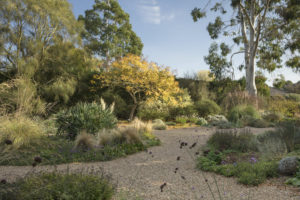
Beth Chatto Gardens, Essex now registered at Grade II © Historic England Archive
The informal garden created by Beth Chatto OBE VMH at Elmstead Market in Essex, created between the 1960s and the early 21st century, is significant worldwide in terms of the history of English gardens. Chatto was an advocate of using plants that worked in harmony with local conditions. Her ‘right plant, right place’ philosophy, radical at the time, still shapes gardening today. Chatto began work on the garden in 1960, transforming seven acres of wilderness which was unsuitable for conventional gardening. She created a series of linked designs to suit contrasting dry and water-logged soils, in areas that became the Mediterranean Garden, the Gravel Garden, the Reservoir Garden and the Water Garden, amongst others. As well as making a success of her revolutionary ecological planting style, Chatto created a designed landscape of the highest standard. She used a series of footpaths, terraces, mature oak trees, stepped ponds and a canalised drainage ditch, as well as her own house, to create a structural framework. She also drew on her knowledge of the artistic principles of ikebana, the Japanese art of flower arranging, with its focus on asymmetrical shapes, and harmony of shape, form, outline and texture. The structural framework for Beth Chatto’s pioneering design survives virtually intact today. Beth Chatto’s garden is open to the public, with access details available on the website.
York Gate Garden, Leeds, West Yorkshire (Grade II)
Addition to the Register of Parks and Gardens
York Gate Garden in suburban Leeds was created from 1951 to the 1980s by gifted amateur designers Sybil and Frederick Spencer and their son Robin. The Spencer family were influenced by the great Arts and Crafts gardens, especially Hidcote in Gloucestershire. Much of the time that the Spencers worked on this influential garden, it was open to the public. Just as they began in the 50s, the middle classes began to fill post-war leisure time with gardening as a hobby. Their design was an Arts and Crafts style garden scaled-down for a small suburban setting, recreating the formal structure of hard landscaping and garden rooms planted in drifts of colour and texture in one compact acre. The Spencers designed 14 interconnecting spaces or ’rooms’, defined and enclosed by a structure of hedges, drystone walls and trees. Each has its own theme and they include a pinetum (or collection of pines), nut walk, paved garden and a white and silver garden, which was planted with white, silver and grey flowering plants. The design also features practical spaces, including herb and kitchen gardens, and built structures including a summerhouse, potting shed, and a forty-foot raised canal as a centrepiece, which the Spencers modelled on Hidcote. The vistas and paths have added interest, with items acquired or designed by Robin Spencer, including a white painted pump at the easternmost point of the Dell, and a tall sundial. York Gate Garden is open to the public, with access details available on the website.
Denmans Garden, Fontwell, West Sussex (Grade II)
Addition to the Register of Parks and Gardens
Denmans Garden was originally the work of self-taught horticulturalist Joyce Robinson, who began developing it in the 1940s, starting the early phase of ornamental designs in the 1950s. Later, John Brookes MBE, recognised as one of the most influential garden designers of the late 20th century, became involved with the site, working with Robinson and eventually taking over in the 1980s. Robinson used inventive design elements and unusual planting combinations. She chose native plants alongside exotics, and introduced new structural elements including two 1977 gravel ‘streams’ which were planted in a naturalistic way with grasses and willow. Brookes was drawn to the ‘ordered confusion’ Robinson created. In 1979 he agreed to run the garden, and Denmans came to define and influence his career. He opened a garden design school at the site and spent 37 years gardening and teaching there. Brookes considered structure, proportion and the connection of a garden to surroundings and architecture as more important than planting. His approach focused on the garden as a functional extension of the house. At Denmans he tested out his ideas, refining Robinson’s layout, adding sculptural elements and giving more exaggerated curving lines to the grass areas and beds. Today Denmans still reflects the ethos of both Robinson and Brookes’ work. Denmans is open to the public, with access details available on the website.
Shute House, Shaftesbury, Dorset (Grade II*)
Addition to the Register of Parks and Gardens
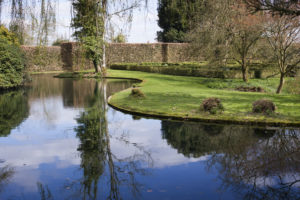
Shute House, Shaftesbury, Dorset, Grade II*
© Historic England Archive
The private garden at Shute House was designed in stages by leading post-war landscape architect Sir Geoffrey Jellicoe, between 1969 and 1988, and later in the 1990s, and is considered to be one of his greatest designs, marking the end of an extraordinary seven-decade career. It dates from Jellicoe’s semi-retirement, when he rediscovered draughtsmanship, and his hand drawn plans demonstrate the evolution of the design over 25 years. In his later career, Jellicoe’s designs became more philosophical in nature, with references to the subconscious and antiquity as well as allegorical themes. The garden is based around a natural spring, diverted into two, with one channel used to create the garden’s more formal elements and the other treated more naturally. The spring reunites in an enclosed woodland garden, then splits again into two series of ponds in a lower open landscape. There are a series of distinctive areas, and the routes between them are carefully laid out to stimulate surprise, delight and even apprehension. Jellicoe had long studied the use of water, and for the rill (the formal channel which forms the theatrical centrepiece of the garden), he created an audio-visual aspect with bronze pipes designed to provide a chorus of different tones to cascading water. Shute House garden is open by appointment for groups only, telephone 01935 814389 for more information.
MEMORIAL
Kennedy Memorial landscape, Runnymede, Surrey (Grade II)
Addition to the Register of Parks and Gardens
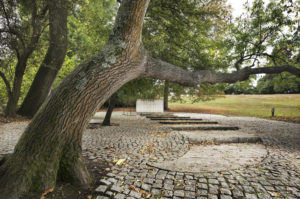
Kenndy memorial, Runnymede, registered Grade II Photo © Historic England Archive
This memorial landscape was designed in 1964-65 by Sir Geoffrey Jellicoe, Britain’s best-known post-war landscape architect. He created it for the British government and the Kennedy Memorial Trust as a memorial to President John F. Kennedy, assassinated in November 1963. The landscape is significant because of the light it sheds on Anglo-American relations during this period, and the international regard for President Kennedy. It is also an important part of the historic landscape of Runnymede, the water meadows associated with the signing of the Magna Carta and the development of democratic government. In his design Jellicoe used the existing landscape but introduced new elements to provide an allegorical narrative based on Bunyan’s ‘Pilgrim’s Progress’. With this work Jellicoe moved towards a greater use of symbolism and subconscious associations, featuring a wicket gate and a steep climb up a flight of 50 steps to an inscribed stone monument. Each step is different, with the entire flight made from 60,000 hand-cut granite setts. The stone memorial tablet at the top is inscribed with the famous quote from Kennedy’s Inaugural Address: “Let every Nation know, whether it wishes us well or ill, that we shall pay any price, bear any burden, meet any hardship, support any friend or oppose any foe, in order to assure the survival and success of liberty”. The Kennedy Memorial is open to the public, with access details available on the National Trust website.
HOUSING ESTATES
Alexandra Road Park, Camden, Greater London (Grade II*)
Addition to the Register of Parks and Gardens
A formal, sculpted landscape within a modern housing estate is rare, which makes this site internationally significant. Alexandra Road Park is an integral part of the Grade II* listed Alexandra Road Estate, which was designed from 1968 by leading public housing architect Neave Brown, and became the first post-war public housing to be listed in 1993. The park, created to be at the heart of the project, is an important collaboration between Neave Brown and the renowned landscape architect Janet Jack. It features walled and sunken play areas, and open spaces including The Mound, skirted by a raised ‘woodland walk’ and The Meadow, planted with lime, cherry and plane trees. The restricted space is used innovatively, using changing levels and diagonal walls and paths to define areas for play and relaxation, each with a distinctive character enhanced by careful planting. Jack’s planting creates shelter and privacy, as well as attracting wildlife, while tough, low-maintenance plants and trees contribute to the landscape’s character of woodland and parkland.
Brunel Estate, Westminster, Greater London (Grade II)
Designed landscape, addition to the Register of Parks and Gardens at Grade II, slide in children’s playground newly listed at Grade II
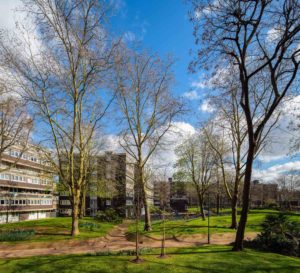
The Brunel Estate, Paddington, London registered at Grade II Photo © Historic England Archive
Michael Brown was a leading landscape architect of the 1960s and 70s- his contribution to the Brunel Estate was planned in 1970. With his designs he brought gentle harmony to urban estates, creating spaces for circulation, play and rest. The Brunel Estate designed landscape is perhaps the most complete public housing project by Brown, and is thought to embody much of why people admire his work. The site is brought together by sinuous red-brick paths and mature trees which provide a sense of permanence, defining the spaces and contours. The design features earth-mounding and carefully detailed brickwork, with play areas formed out of complex brickwork forms. The play area for older children is still essentially as designed, and the monumental slide structure, listed today, is a rare surviving example of a play structure from this period, representing the 20th century move towards encouraging more adventurous play. Very few items of play equipment have been listed, and this is a particularly ambitious and inventive creation.
Golden Lane Estate, City of London (Grade II)
Addition to the Register of Parks and Gardens
The Golden Lane Estate was designed and constructed over ten years from 1952 by architectural practice Chamberlin Powell and Bon (CPB). CPB became one of the most important Modernist architectural firms in post-war Britain. The estate is seen as one of England’s most successful 1950s housing developments, recognised by the Grade II and II* listing of the buildings. The landscape design makes careful use of complex levels left by the buildings previously on the site, to create a series of intimate courtyards linked by pedestrian thoroughfares and features such as pools, the rotunda and roof gardens. At Golden Lane, the spaces and the relationships between the blocks are as important as the buildings. CPB believed only strong, simple forms could survive, and that when looking down from the upper flats, these would form part of the overall pattern of the estate. The complex landscaping and use of levels anticipate CPB’s later landscape design at The Barbican, already registered at Grade II*.
Water Gardens, Burwood Place, Edgware Road, Greater London (Grade II)
Addition to the Register of Parks and Gardens
The Water Gardens, designed in 1961, is a rare example of a mid-20th century landscape as a centrepiece for a private luxury development, at a time when most developments were for public housing. Landscape architect Philip Hicks’ brief was to create a setting for the development and conceal a basement car park. His ambitious solution was to create a Modernist urban water garden using the roof slab of the car park as the base of the pools. With sharp, clean lines, asymmetric design and geometric forms, the Water Gardens is characteristic of the Modernist movement. The Gardens feature a Brutalist use of concrete with contrasting soft planting, and the fluid movement of water in pools and fountains. Hicks designed the landscape to provide attractive views from flats above and at ground level, as well as a space to be used, for which he created extensive paved areas and terraces. Flying staircases, raised walkways and platforms provide points of visual interest, as well as access to the upper decks. The garden is a hidden oasis of tranquillity, created by limited views out of the site and fountains that block traffic noise from Edgware Road.
Churchill Gardens Estate, Pimlico, Greater London (Grade II)
Addition to the Register of Parks and Gardens
Built between 1947 and 1962, Churchill Gardens in London was the first large-scale housing development in Britain created after the Second World War. With both the buildings and landscape winning praise from the outset, the project is regarded as a key example of post-war social housing by Philip Powell and Hidalgo Moya, pre-eminent architects of the period. The layout and architecture borrow from European models, but the landscape is evocative of traditional London squares. It is a high-density mixed development with housing units of different sizes and types within carefully planned open spaces, which separate the housing blocks and give a sense of scale. The landscape is a mixture of traditional and modern hard landscaping materials: yellow stock brick, concrete, granite setts and black-painted steel railings. There are a large number of mature and young trees of varying species- pseudo Acacia, Hornbeam, Lime, Norway Maple and Whitebeam. An innovation on the estate, which worked until 1983, was heating via a system supplied by waste heat pumped through a tunnel from Battersea Power Station across the river Thames. The Churchill Gardens Estate designed landscape joins eight other buildings from the scheme which are already listed at Grade II.
Fieldend, Twickenham, Middlesex (Grade II)
Addition to the Register of Parks and Gardens

Fieldend, Twickenham, Middlesex, registered at Grade II Photo © Historic England Archive
Fieldend is a private estate of 51 houses designed by Eric Lyons & Partners for Span Developments in 1959-60, in close collaboration with landscape architect Michael Brown. Span was one of the few speculative house-builders in this era creating progressive, architect-led housing. Architect Eric Lyons believed landscape was not just the treatment of space left between buildings, but the arrangement of buildings to create spaces. At Fieldend, houses had no private front gardens- the communal landscape continued up to individual front doors so paths and planting could flow freely, integrating building and landscape. The staggered terraces look across open lawns, mature trees and evergreen shrubs. The layout favoured pedestrian over car, with parking in a separate square. Admired by critics from the outset, its design survives well.
Alton East & Alton West, Roehampton, Greater London (both at Grade II)
Additions to the Register of Parks and Gardens
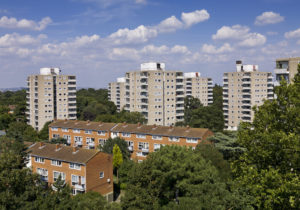
Alton East, Roehampton, added to the Register at Grade II © Historic England Archive
Built in the 1950s, the London County Council (LCC) estates at Roehampton were amongst the most important post-war mass housing schemes built in Britain, gaining an international reputation. The landscaping is an integral component of their design. The contrasting styles of the Alton East and Alton West estates reflect two competing architectural styles in the LCC Architects’ Department in the 1950s, which drew on two distinct strands of European modernism. In their design for Alton East the LCC Architects’ Department team juxtaposed monumental post-war architecture with the landscaping for the Victorian villas that had occupied the site. The architecture and informal landscaping are a manifestation of the design team’s Swedish-humanist-inspired style. The design kept some 700 mature Victorian trees, creating informal tree-lined roads and paths throughout the estate while green open spaces flow between the housing blocks. Structural elements such as brick walls and planters were constructed to match remnants of the earlier Victorian garden walls.
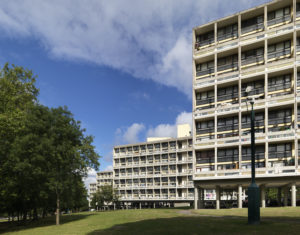
Alton West, Roehampton, added to the Register at Grade II © Historic England Archive
The design of the Alton West estate was more inspired by the approach of renowned architect of the International Style, Le Corbusier. It includes pensioners’ bungalows now listed at Grade II, sculpture by Robert Clatworthy, housing blocks listed at Grade II*, and Mount Clare – a historic house listed at Grade I. In their design for the estate, the LCC Architects’ Department considered the 18th century landscapes associated with Mount Clare and Downshire House, in deciding how to place key buildings. One of their intentions was to form a connection between Downshire House and Mount Clare, on the northern and southern slopes of the site, to create the feeling of an endless grass carpet, with vast open vistas amplified by sparse planting.
URBAN GARDENS AND PARKS
Campbell Park, Milton Keynes, Buckinghamshire (Grade II)
Addition to the Register of Parks and Gardens
Early plans for Campbell Park were proposed between 1972 and 1977, led by landscape architects Tony Southard and Andrew Mahaddie. Neil Higson drew up a new masterplan in 1980. The park forms a central feature in the plan of the Milton Keynes, Britain’s most successful post-war new town. Campbell Park as it stands today is one of the largest urban park landscapes created in England in the 20th and 21st century. It fuses contemporary design with 18th and 19th century influences, forming a point of transfer between the city centre and the wide, pastoral landscape beyond. The design combines natural and artificial topography in a unified scheme that includes water features, sculpture, the Grand Union Canal, a cricket pitch and an open-air auditorium, with planting and planning considered to encourage biodiversity.
Harlow Town Park, Essex (Grade II)
Addition to the Register of Parks and Gardens
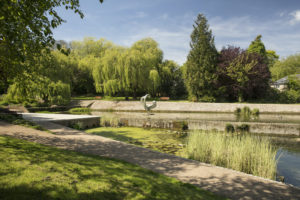
Harlow Town Park, Essex, registered Grade II © Historic England Archive
Harlow Town Park was planned between 1949 and 1953 by the planner and architect Sir Frederick Gibberd, and the landscape architect Dame Sylvia Crowe DBE. Detailed designs were produced by landscape architect John St Bodfan Gruffydd and Harlow Urban Development Corporation’s engineer and surveyor AWR Webb. It is a rare example of a new park associated with a first-generation new town. The park is an environment intended for active public use, successfully blending formal park design with existing landscape features including undulating topography, gravel works and watercress beds. The design incorporates the old hamlet of Netteswell Cross, in a rare early example of a conservationist approach to planning. This is a fine example of a post-war public park where the structural framework and key features including the bandstand, the formal gardens, footpath and canalised stream survive largely intact.
Roper’s Garden, Cheyne Walk, Chelsea, Greater London (Grade II)
Garden, addition to the Register of Parks and Gardens; ‘Awakening’ sculpture newly listed at Grade II
Roper’s Garden was created on the site of Second World War bomb damage- the buildings which previously stood here were destroyed by a parachute mine on 17 April 1941. The garden was first planted by the Chelsea Society, before plans were commissioned from Peter Shepheard in 1960. Shepheard was well-established in architecture, landscape architecture and town planning. He used basements of the terraced housing previously on the site to create a secluded, sunken garden to keep a connection with the site’s history and reduce traffic noise from Chelsea Embankment. It is a successful example of one of many urban public spaces created in the aftermath of the war, and of the restrained designs of Peter Shepheard. The centrepiece of the garden, Gilbert Ledward’s bronze-cast ‘Awakening’ sculpture, listed today, is an important original element of the garden. Ledward has a strong connection to the area having lived and worked in Chelsea throughout his career.
The Improvement Garden at Stockwood Park, Luton, Bedfordshire (Grade II*)
Addition to the Register of Parks and Gardens
The Improvement Garden was designed in the 1980s by Ian Hamilton Finlay, and remarkably well-maintained, it is now the only complete garden remaining in England by this artist, poet and landscape designer. The garden’s six sculptures and their setting integrate poetry, history and nature, providing an overview of the themes that dominated Finlay’s work. The inspiration for the sculptures and design range from Greek mythology and Roman architecture to the grand landscape gardens of the 18th century. The design is a fine example of Finlay’s collaboration with the sculptors and carvers he used in his later career, and with the gifted Bob Burgoyne. It is part of an important ensemble of buildings and garden design that has evolved over 300 years, including the Grade II listed 18th century stable block and the 19th century walled gardens and glasshouses.
INSTITUTIONAL
St Catherine’s College, Oxford (upgraded from Grade II to Grade I) on the Register of Parks and Gardens
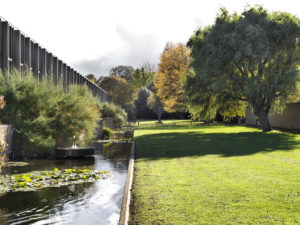
St Catherine’s College, Oxford, now upgraded to Grade I Photo © Historic England Archive
The landscape at St Catherine’s College was created as part of a comprehensive plan with its buildings by Arne Jacobsen during the 1960s. Jacobsen, from Denmark, was one of the foremost architects and designers of the mid-20th century. The scheme is Jacobsen’s only completed commission in England. It is a highly unusual and complete integration of architecture and landscape, all created on a 3-metre square grid, unifying the whole in scale and planning. In the long central garden yew hedges and walls create a network of ‘rooms’ for studying and socialising. The walls extend the buildings’ form and materials into the landscape, and elements from the landscape are reflected in the buildings. The landscape was first included on the Register at Grade II in 1998, while the accompanying buildings were listed at Grade I in 1993. As a single, contemporary scheme, landscape and buildings are of equal significance, and today the landscape is upgraded to Grade I.
INDUSTRIAL
Cummins Engine Factory landscape (Grade II)
Addition to the Register of Parks and Gardens
The landscape at Cummins Engine Factory in Darlington was designed between 1964 and 1966 by Dan Kiley, considered to be the father of modern landscape architecture in the United States. Listed at Grade II*, the Cummins Engine Factory by Roche & Dinkeloo is one of Britain’s great post-war buildings. Kiley worked closely with architect Kevin Roche to create a deceptively simple landscape of grass, inset with a rectangular reservoir fronting the imposing factory building. The design strips back the three principle elements of landscape design – trees, water and grass – to a minimalist and pure form, using a limited palette of materials for the hard landscaping, to complement the main building. The reservoir is kerbed by the same blue brindle bricks used in the factory building and acts as a reflecting pond. The site is bounded by original Cor-ten fencing, (listed at Grade II*), of the same red coloured oxidising steel as the building.
Jellicoe watercourse at the former Cadbury Factory, Moreton, Wirral (Grade II)
Newly listed
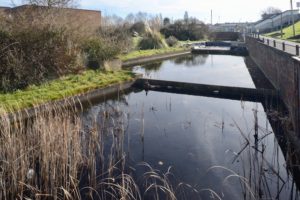
The Jellicoe watercourse at the former Cadbury Factory, Moreton, Wirral, now listed Grade II Photo © Historic England Archive
The watercourse was designed by Sir Geoffrey Jellicoe, one of the leading landscape architects of the 20th Century, in the early 1950s. A modern interpretation of an 18th century ha-ha, the watercourse had a functional and aesthetic role, designed to act as a physical barrier, as well as a decorative feature for employees and visitors to enjoy. The innovative design incorporates a series of weirs or cascades on a site with very flat topography and makes clever use of false perspectives to give the illusion of distance. It has a pivotal place in Jellicoe’s career, being his first large-scale concrete water feature and where he first explored illusion, perspective and scale, developed further in his later works. This is a rare survival of an early-1950s landscape feature on an industrial site. It reflects the ideas of modern landscape design developed from the Festival of Britain in 1951 when appetite grew for landscaping industrial sites to create better environments.
COMMERCIAL
Broadwater Park, Denham, Buckinghamshire (Grade II)
Addition to the Register of Parks and Gardens
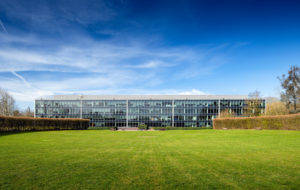
Broadwater Park, Denham, now registered at Grade II © Historic England Archive
Broadwater Park was designed in the early 1980s by Preben Jakobsen as the setting for a new out-of-town office block, by architectural firm EPR. Jakobsen became an acclaimed specialist in creating landscapes for the wave of commercial and public sector office developments built on suburban sites in the 1980s. Broadwater Park is the most extensive and best surviving example of his work. Jakobsen was preoccupied with geometry in his design, and he considered order, structure and a design skeleton all essential components of a good landscape. The site is rationally planned, combining formal and traditional elements to form a series of distinct areas. The layout is informed by the mirrored office building, designed at the same time with input from Jakobsen.
Stockley Park, Uxbridge, Greater London (Grade II)
Addition to the Register of Parks and Gardens
Stockley Park was planned in 1984, and is a pioneering example of business park design and a skilled reuse of highly contaminated land, developed as an undulating landscape on a former gravel works. High-quality design was central to the appeal of business parks, which began to be developed in Britain in the 1980s, and Stockley Park is the result of a collaboration between several notable designers, engineers and landscape architects. Its design shows influence from 17th century English and French landscapes, for example, the car park courts, enclosed by clipped hedges, were inspired by the ‘green’ compartments found in French landscape design, while the avenues of lime trees that line the pedestrian routes reflect the formal avenues that ran through the landscape of Dawley Park, which had occupied the site. Its fully integrated design sees the cellular business park contrast well with the naturalistic and geometric forms of the golf courses and public park.
Photos © Historic England Archive

